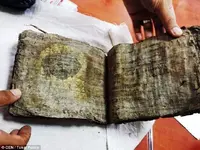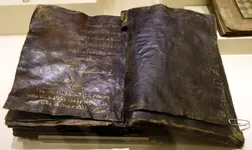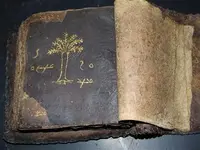Hello Saddam
There is several factors you need to consider.
Its a sad fact. It has been discovered 20% of artifacts and even documents in Museums and archives around the world are fake. Either by skilled forgers for financial gain or even by 20th century academics wanting notoriety.
Many a famous highly regarded museum or very rich private collector have been left red faced. So as you can imagine when a find such as this. No longer they take these artifacts on face value. Thus today such items come under intense scientific, historic and academic scrutiny.
1. No buyer will part with serious money without forensically examinging the document.
2. Without proper forensic document authentication of the bible it has no financial value or than a historical curio unverified.
3. Without Provence Showing legal owner ship the artifacts have no value for a buyer.
For example a sticking rich billionaire has money. Why because they are smart. Now when they make purchases the whole idea of buying historical or religious artifacts or art. is hide money for taxation minimization purposes while over time the artifact will gain value.
Have you ever wondered why some long dead 19th century famous artist painting sells for a 100 million or so? Why its certainly not the actual face value of artwork was made of? A bit wood and canvas with some paint on it?
But you see historical or religious artifacts or art in the real world is not seen as cultural heritage but as a cryptocurrency. To hide in plain sight vast sums of money from taxation by the super wealthy and large corporations.
So for a billionaire they do not care what the items is as long as if has Provence, Academic and scientific verification on the authenticity of the object.
If you cannot provide the 3 things above then you have nothing of value. Rather historical value not financial value. And if you cannot provide Provence you could end up in jail like people involved in the stories below.
Also as you can see below It appears there is crowded market for ancient Bibles these days?
in 2015 Smugglers tried to sell the Bible below to under police officers.
A 1,000-year-old Bible has been uncovered by police in Turkey after smugglers tried to sell the priceless book to undercover officers.
Police in the central Turkish city of Tokat confiscated the ancient Bible together with other priceless artefacts after catching the smugglers red-handed.
Three men have who were attempting to sell the Bible, written in the old Assyriac language, to undercover police officers have been arrested.

Another Bible was discovered in 2000.
The relic was rediscovered in the Ankaran Justice Palace and believed to be written in Syriac, a dialect of the native language of Jesus.

The Bible was already in custody of Turkish authorities after having been seized in 2000 in an operation in the Mediterranean area in Turkey. The gang of smugglers had been charged with smuggling antiquities, illegal excavations, and the possession of explosives. Turkish police testified in a court hearing that they believe the manuscript is about 1500 to 2000 years old.
The manuscript carries excerpts of the Bible written in gold lettering on leather with lines of Syriac script with Aramaic dialect.
After waiting eight years in Ankara, the ancient Bible is being transferred to the Ankaran Ethnography Museum with a police escort. Turkish authorities express the Bible is a cultural asset and should be protected.
The Vatican reportedly placed an official request to examine the scripture.
This copy of the ancient Bible is valued as high as 40 million Turkish Liras (28 million dollars).
Now remember valued only at that price providing the item has Provence, Academic and scientific verification. No multimillionaire is going to hand money over only to have it confiscated by authorities for lack of Provence or buy the item without Academic and scientific verification. The whole idea of the wealthy is hide money from Taxation not lose it?
Thirdly in 2009
NICOSIA (Reuters Life!) - Authorities in northern Cyprus believe they have found an ancient version of the Bible written in Syriac, a dialect of the native language of Jesus.

The manuscript was found in a police raid on suspected antiquity smugglers. Turkish Cypriot police testified in a court hearing they believe the manuscript could be about 2,000 years old.
The manuscript carries excerpts of the Bible written in gold lettering on vellum and loosely strung together, photos provided to Reuters showed. One page carries a drawing of a tree, and another eight lines of Syriac script.
Experts were however divided over the provenance of the manuscript, and whether it was an original, which would render it priceless, or a fake.
Experts said the use of gold lettering on the manuscript was likely to date it later than 2,000 years.
“I’d suspect that it is most likely to be less than 1,000 years old,” leading expert Peter Williams, Warden of Tyndale House, University of Cambridge told Reuters.
Turkish Cypriot authorities seized the relic last week and nine individuals are in custody pending further investigations. More individuals are being sought in connection with the find, they said.
Further investigations turned up a prayer statue and a stone carving of Jesus believed to be from a church in the Turkish held north, as well as dynamite.
The police have charged the detainees with smuggling antiquities, illegal excavations and the possession of explosives.
Syriac is a dialect of Aramaic - the native language of Jesus - once spoken across much of the Middle East and Central Asia. It is used wherever there are Syrian Christians and still survives in the Syrian Orthodox Church in India.
Aramaic is still used in religious rituals of Maronite Christians in Cyprus.
“One very likely source (of the manuscript) could be the Tur-Abdin area of Turkey, where there is still a Syriac speaking community,” Charlotte Roueche, Professor of Late Antique and Byzantine Studies at King’s College London told Reuters.
Stories regarding the antiquity of manuscripts is commonplace. One case would be the Yonan Codex, carbon dated to the 12th century which people tried to pass off as earlier.
After further scrutiny of photographs of the book, manuscripts specialist at the University of Cambridge library and Fellow of Wolfson College JF Coakley suggested that the book could have been written a good deal later.
“The Syriac writing seems to be in the East Syriac script with vowel points, and you do not find such manuscripts before about the 15th century.
“On the basis of the one photo...if I’m not mistaken some words at least seem to be in modern Syriac, a language that was not written down until the mid-19th century,” he told Reuters.
As you can see the Market for Ancient Bibles is a little crowded at present. None have of above have proven Provence, Academic and scientific verification. Thus only valuable as historical item but not of financial value.
So for now please think about this?
Some thing worthless without Provence, Academic and scientific verification is it worth going to jail for?
Crow






